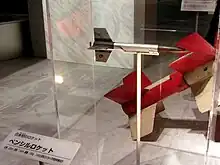Pencil Rocket
The Pencil Rocket (ペンシルロケット, Penshiru roketto) was developed by the Avionics and Supersonic Aerodynamics (AVSA) research group in the early days of the Japanese space program.[1] A prominent engineer on the project was Hideo Itokawa. The rocket was first launched on 12 April 1955. The dimensions were 23 cm in length by 1.8 cm in diameter, weighing 200 grams.[1]
 Pencil Rocket. Exhibit in the National Museum of Nature and Science, Tokyo, Japan. | |
| Function | Technology demonstration |
|---|---|
| Manufacturer | Avionics and Supersonic Aerodynamics |
| Country of origin | Japan |
| Size | |
| Height | 23 cm (9.1 in) |
| Diameter | 1.8 cm (0.71 in) |
| Mass | 200 g (7.1 oz) |
| Stages | 1 |
| Launch history | |
| Status | Retired |
| Total launches | 29 |
| First flight | 12 April 1955 |
| Last flight | 23 April 1955 |
Development of the Pencil rocket system started in 1954 when Hideo Itokawa formed a center for rocket development at the University of Tokyo. In 1955, Itokawa's team, began conducting experimental launches of pencil-type rockets.[2] The team launched 29 rockets over their course of these first experiments in space launch.[1] Afterwards, the team expanded its focus to atmospheric observation with the larger Kappa 6 rocket.[2]
Japan donated a full-scale replica of the Pencil test rocket to the U.S. National Air and Space Museum in 1974.[3]
References
- Matogawa, Yasunori (21 May 2005). Pencil Rocket Story: The Dawn of Japanese Space Development. JAXA.
- Arina Tsukada (January 29, 2022). "How Japan became the world's second largest investor in space ventures" (PDF). Sustainable Japan Magazine. The Japan Times. Retrieved March 4, 2023.
- "Model, Rocket, Test, Pencil". National Air and Space Museum. Retrieved March 4, 2023.
External links
![]() Media related to Pencil Rocket at Wikimedia Commons
Media related to Pencil Rocket at Wikimedia Commons